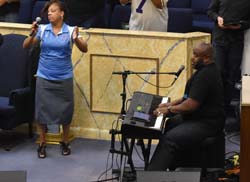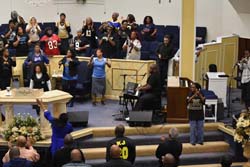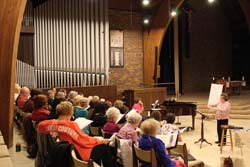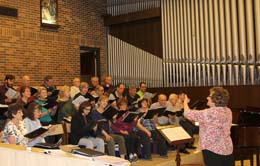Singing To the Glory: Church-based Choirs and Ensembles in Baton Rouge
By Liz Williams
Editor's Note: This essay was researched and written before the tragic shootings of July and flood of August 2016.

Introduction
All over Baton Rouge, people are singing together. They are singing night and day; they are singing every day of the week, they are singing on all sides of town. Baton Rougeans are constantly gathering as choirs to worship God, sing praise to Jesus, and to celebrate their faith and each other. Many of these choirs are crossing lines and boundaries that once kept them apart: race, culture, denomination, definitions of sacred, and multiple eras of history. They cross these lines to join together in song as a pathway to unity with God and their community.
The focus of this essay is sacred music traditions in Baton Rouge. These traditions reflect the unique cultural landscape of Baton Rouge and its hybrid history which is a significant, but often unseen, aspect of the identity of contemporary Baton Rouge.
The cultural heritage that emerged from this history is a distinct Anglo-African tradition seasoned with multiple French influences (Cajun, Creole), minimal Spanish influences, and many others. It is no accident that, over 200 years later, the boundaries of the Republic of West Florida in 1810 shown in Map A are identical to the boundaries of what is in 2016, a blended border zone of Protestant and Catholic religious affiliation by parish (Map B) between the bulwarks of the Protestant zone of north Louisiana and the Catholic zone of south Louisiana (with the exception of decreasing Catholicism in Iberville Parish). In 1810 and in 2016, Baton Rouge lies in the center of where these two zones meet and blur.

The repercussions of this history are reflected in the sacred music traditions practiced in Baton Rouge in 2016. Baton Rouge is a cultural estuary. In Baton Rouge in 2016, the fact that Baptist and Catholic traditions predominate among many, many others is a reflection of Baton Rouge's colonial history. Like the meeting of fresh and salt water, the two major religious and cultural traditions that shaped this country and this state come together here. The Anglo-Protestant (primarily Baptist) traditions of north Louisiana and the southeastern U.S. meet head on with the Latin Catholic traditions of South Louisiana and both comingle with their African-American interpretations. All of these traditions have clashed and blended within the boundaries of East Baton Rouge Parish (Meyers 1976).
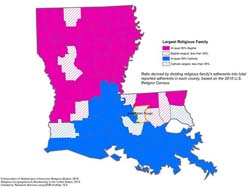
Baton Rouge is fondly known by locals as a big small town. It is also a city with a history of religious tension between Catholics and Protestants and racial tension between blacks and whites. It is significant that the first African-American bus boycott was organized and implemented in Baton Rouge in 1953, before the better-known Montgomery Bus Boycott in 1955 (Melton 2013). Baton Rouge is known as a friendly place by many but it is also known as a city with a palpable racial divide and in 2015 was described by local, national and international news organizations as two different cities, one black and one white (Yee 2015, Business Report 2014, McCormack 2013, Baton Rouge Area Chamber 2009).
Martin Luther King once said that 11:00 am on Sunday morning is the most segregated hour in America. He was talking about Christian churches, black and white, being segregated. At first glance, one might see this as the case in Baton Rouge and other places. And yet, there are several groups and organizations in Baton Rouge working to build bridges between all citizens of the city. One of these bridges is the sharing and exchange of sacred music traditions. Just sixty years ago, it was uncommon for Baptists and Catholics to enter into each other's churches or for blacks and whites to worship together. These lines are not gone but they are blurring, slowly, and people are using sacred music to cross them. It is important to note that, especially in church, some of the divisions are about preference and cultural heritage and not prejudice. The Interfaith Federation of Greater Baton Rouge's annual Sounds of CommUnity concerts are highly visible, but many other efforts happen throughout the year.
There are so many sacred music traditions practiced in Baton Rouge, it is a daunting task to document even a small sample. The colonial currents that shaped Baton Rouge are reflected today in the fact that the majority of people in Baton Rouge are Baptist or Catholic (Map B). The focus of this essay is on some examples of these traditions. Numerous other faith traditions practiced in Baton Rouge are documented in other essays.
In different churches in Baton Rouge, a person can find traditional Negro Spirituals, Christian hymns, anthems, classical religious pieces, many genres of Southern Gospel, Black Gospel and contemporary Christian music. It is possible to see a Catholic choir director, who loves bringing ancient Gregorian chant to life in her church, dancing in the aisles of a Southern Baptist Church during a Gospel concert. On a different day, you can see a Catholic Church full of people swaying to the sound of a Gospel choir singing a song written by a Pentecostal minister. Such is the sacred music in the cultural estuary, the cultural mixing zone that is Baton Rouge.
This essay is an exploration of these traditions though the lens of ten Baton Rouge sacred music practitioners who were consulted and interviewed for this essay. Their selection was not random but guided by previous fieldwork and from sacred music concerts coordinated by ecumenical movements. Many of the participants in this research came from these groups and some did not. All participants are from different churches and choirs. However, the social network of connections and interconnections between choirs, choir directors, and sacred musicians in Baton Rouge is a complexly interwoven tapestry, an intricate social network.
Several consistent themes emerged from these interviews but first, it is instructive to consider some of the themes from the groups that chose not to participate. In the realm of sacred music, there is a fine line between worship and entertainment. This theme came up in almost all of the ten interviews summarized here. Several churches said that their sacred music did not belong in this study because it is worship and ministry, not entertainment. They felt it should not be viewed in any way as an aspect of the arts, culture, recreation or tourism. One person who leads a dance ministry who did not participate in the project clearly stated the distinction from her perspective. She said that dance is an art and that she uses the arts for worship and ministry but not for art—not as performance or to entertain but strictly as ministry.
Another issue that gave some people pause is the use of the word, folk. This word has many connotations. In this essay, it is used to refer to what the people of the community are doing. It is also used in the context of tradition which indicates that a practice has been shared through generations. When documenting folk traditions in an urban industrial center such as Baton Rouge, folk traditions might be disguised as complex contemporary manifestations of older folk traditions. These traditions survive today because they are living, dynamic traditions that are constantly interpreted and reinterpreted in terms of the present.
In spite of declining numbers nationally in choir participation, Baton Rouge is the home to many sacred music/church choirs (National Congregations Study 2007). Music ministers and choir directors are some of the busiest people in Baton Rouge. None of them participate in just one choir, but rather many. Their networks and connections expand with each musical program they coordinate and share with the community. There are common character traits among the ten people profiled here: they are ardent in their faith and ministries, they love people, they love to sing, love to share their talent, they love community, and they make things happen. Most of them are from multiple generations of families that share a passion for their faith and for sacred music. Another commonality is the challenge of meeting the needs of choirs and congregations by finding the balance between traditional and modern music. Some address this issue by having different choirs; others may blend both in the recreation of several songs. All stressed the amount of work involved in choir and song. Many used the word commitment to describe what is necessary for a successful music program. As each addresses the challenge of balancing the traditional and the contemporary, they maintain their faith and their community traditions in the way that humans have always maintained tradition; they interpret and reinterpret what is important in terms of the present. Their connection with God and the Holy Spirit fuels their spirituality which engenders the creativity necessary to create an atmosphere conducive to worship and a connection with God and each other.
In the ten profiles that follow, the music ministers and choir directors describe their faith and profession, and they illustrate the way that they work to facilitate the connection between themselves, God, and community. Whether they are from Baton Rouge or Louisiana or elsewhere, their words indicate a strong sense of community and place, of home, in Baton Rouge. This sense of place shows the rootedness and bonds created through sacred music that transcend and might lead to the healing of a fractured, yet inextricably linked community.
Church Choirs
J'Michael Francois, Program Director at WXOK spends a lot of time in a lot of churches. He said that the choir is the "nucleus" of the church and that the strength and vigor of the church can be felt by the strength of its choir. The four church choirs and their directors profiled in this section are a testament to his statement. All four are strong choirs. Some of these choirs are small and others are large. They worship with very different types of music and they show that strength can be felt in music that is soft and music that is bold. It seems that the sacred music sung by these three choirs is a reflection and affirmation of religious, ethnic, and family identity. A common thread in the interviews conducted for this study is that the role of the choir is to prepare the congregation to receive the Word of God. Through music and the nuance of atmosphere, all four of these choirs facilitate the invisible but palpable connection between people and God.
Timothy Britten
Music Minister, Interdenominational Faith Assembly, Church of God in Christ
Gospel Choir Leader, Minister Timothy Britten and the Shabach Praise Company
Minister Timothy Britten, a Baton Rouge native, has multiple ministry roles. He is the leader of the Gospel choir called Minister Timothy Britten and the Shabach Praise Company, is Music Minister of the Interdenominational Faith Assembly, plays for two Baptist churches, plays the key board, produces sacred music, and creates it. Sacred music is a major aspect of the Britten household; his wife sings in the choir, his son is a keyboardist and his daughter is the lead singer on some of the songs on his latest album, You are My God. He grew up in church. His father was a preacher and his mother sang and played the organ. He remembers coming home from church as a four-year-old child and going straight to the family piano to play until he could recreate the music he had just heard. His mother tried to get him to take piano lessons, but he had already learned to play by ear. He recalled members of the Voices of Zion, a large Baton Rouge Community Choir, singing in his home. In 2005, he and his choir—Minister Timothy Britten and the Shabach Praise Company—were nominated for both a Stellar and a Grammy award for Best Gospel Choir or Chorus Album for his album and title song, Can't Nobody Do Me Like Jesus (Gernhauser 2005).
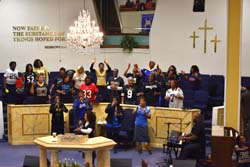
He grew up listening to many of the luminaries of early Baton Rouge Gospel and recalled the talents of members of the Voices of Zion, Leo Perkins, William Smart, Elwood Clayton Gaines and Richard Sterling. He remembered when the "great" Paul Simon, also of Voices of Zion, visited his parents when he was a child. When nationally-known Gospel singers such as James Cleveland and Shirley Caesar came to Baton Rouge, he said, they would perform at Buchanan Elementary School and locals would often sit in and/or sing with them. Some of the local musicians were discovered by the national artists and went on to their own national careers.
Minister Britten describes his music as Black Gospel. At age nine, he started to play for his church and at 12 was playing for two other churches as well as the Voices of Praise choir of the Church of God in Christ Louisiana State Convention. Kenneth Mitchell was the director of this choir, which performed around the country. Minister Britten acknowledges Kenneth Mitchell as a major musical influence and a "great inspiration in his life." In the early 1970s, Minister Britten said that Baton Rouge was a "traditional city, especially when it came around to music." Traditional Gospel was the norm, but Kenneth Mitchell brought contemporary Gospel "onto the scene and changed the scope of music here in the city." Although he likes the movement toward contemporary Gospel, he continues to play traditional Gospel and said Thomas A. Dorsey, the "godfather of Gospel," has been a major influence on his music.
While singing and playing with Voices of Praise at a Baton Rouge church on Myrtle Street, he was discovered by the nationally renowned Gospel singer, Reverend James Moore of Detroit. Minister Britten started touring the country and the world with Reverend Moore when he was 21 years old. Reverend Moore was known for his great voice and appreciation for both traditional and contemporary Gospel music (Bush: 2015). Minister Britten described Moore as "a great psalmist; a singer who can really hear from God and can change the atmosphere in a service, one who can bring the spirit of God into the room." After playing with Moore for a year, Minister Britten played on a live national recording and two years later, Minister Britten played on Moore's recording of the world renowned Mississippi Mass choir. Sadly, Moore died in 2001 at the young age of 44 but not before he facilitated Britten's creation of his own choir (Gernhauser 2005).
After traveling the world and being nominated for a Grammy, Minister Britten has received offers to live and work in many parts of the country but he said he is not moving. He said it is good to leave Baton Rouge to travel and to learn from what is going on in other places, however, he is a self-described people person and says there is no place like Baton Rouge. He describes the people as friendly; he loves the abundance of trees, and of course, the cooking.
In addition to his two choir mentors, Minister Britten said he studied music by listening intently during the years he spent on the road. He listened to and watched performances but also learned what to do and not to do during performances by paying attention during recording sessions and meetings. In comparing sacred music in Baton Rouge and New Orleans, he noted that Baton Rouge music has a much more laid back feeling and he finds it is less produced than music from New Orleans. He observed that "jazz flows back into the church in New Orleans", something that does not happen in Baton Rouge. He said that when he auditions singers for his choir, he looks for actors and actresses and people who can sing with their whole body which he considers an instrument. He wants people who can get notes out and people who can sign because he wants singers who can "paint pictures" for congregants including, but not limited to, those who are hearing impaired. One the most important traits that he seeks to maintain in himself and in those he auditions is openness, people who "remain teachable" because he believes that practitioners of sacred music should never be complacent.
In regard to music played in church, he believes that the music has to offer something for everyone, youth, elders, and those in the middle, which means it must be well balanced. While many want contemporary Gospel, he states that "contemporary is just that, here today and gone tomorrow whereas the hymns will always be there." The denomination of the hymn doesn't matter to him, "because music is music and we are in a time now in the Black church that you want to take the hymns out because it is all about the contemporary now," but the power of the words and the stories behind all the hymns are the "foundation" of a well-balanced music department. In an effort to reach all ages of the congregation, he will blend a verse from a hymn into a contemporary Gospel piece.
In regard to collaborating with the Pastor, he learned a valuable lesson from Rev. Moore who said the music minister must pay attention to who is at the microphone and musically "be where he is going to be, not where he is." It is critical that the music minister and the Preacher be "of one accord" so that they may "usher in the presence of God together." He explained further that the music minister must be highly observant, especially if he is at a church where he does not know the Pastor. Before the music or singing begins, he tries to "feel the room out" to determine whether or not he needs to change the atmosphere because "sometimes the atmosphere is not set for the Preacher's word, and we have to learn how to set the table, so that we can eat." In order to set the table, he said, "You have to spend time with God and know your house."
He recalled a painful lesson he learned as a young man when he knew God was telling him to play the song, "I'll be Shelter in the Time of the Storm." He said he "got into an argument with God" and played the song he wanted to play because he felt like it would "get house." He played a song that had nothing to do with rain, but when it was time for the Preacher to share the Word, she came out with an umbrella to make a point about how God protects His people. He was devastated, but it is a lesson he will never forget.
He said that it is important to be careful with music because it is "a spirit, a very powerful force." He went on to describe his philosophy as a music minister and revealed his sense of wonder:
You can tell the difference between a person who really spends time with God and spends time with their craft compared to someone who just gets up and just does what they do. Black Gospel is amazing because of the things God allows us to hear, musically. . . . Black Gospel is in a class by itself but I like to listen to Bill Gaither and other artists too because, once again, you like to remain teachable. I love big band, Tony Bennett, Michael Bublé, just to wonder how they hear what they hear, what is their approach to the type of music that they do? (Britten 2015)
In December 2015, Minister Timothy Britten and Shabach Praise Company ministered with music at the Women's and Men's Conference hosted by The Ministry of Love on Hooper Road. This conference was very much a celebratory festival of faith and music that included several dance ministries and praise and worship groups from Baton Rouge. Minister Britten and Shabach spanned the genres and melded traditional Gospel with modern Praise and Worship to the overwhelming joy of the congregants.
Carla Landry
Choir Director, St. Agnes Catholic Church
Carla Landry is the Choir Director at St. Agnes Catholic Church. She leads the choir in the celebration of the Latin Mass, the western European version of the Mass that was celebrated in the same way for over 1500 years. Between 1962 and 1965, Catholic leaders met in Rome and worked to make the church more relevant in the modern world. This process of meetings is referred to as Vatican II and resulted in many changes to the Catholic Church and the Catholic Mass. These changes included the option for churches to hold services in the local language of the community instead of Latin and allowed for ecumenical prayer and sharing. In the United States, among several other changes, this meant that the Catholic Mass began to be celebrated in English and that Protestant hymns were incorporated into the Catholic music repertoire. While many Catholics welcomed these changes, others felt that the church had been Protestantized and Americanized (Ruff 2013).
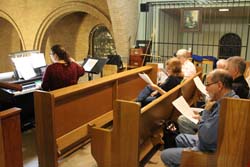
Ms. Landry was born in 1969, four years after Vatican II. As a child and young adult, she never liked the Americanized version of the Catholic Mass even though she had only experienced vestiges of the earlier version. Vatican II coincided with the folk music trends of the 1960s and one of the results is the guitar/folk Mass. While it may have helped to keep youth in church, the folk Mass horrified some Catholics accustomed to the formal ritual of the Latin Mass and the ancient, traditional, and ordered sounds of Gregorian chant. Although she was a child at the time of the changes, Ms. Landry was not fond of them. She felt that worship and Mass should be a place apart from everyday life. To her, the guitar Mass sounded like what she heard on pop radio; "there was nothing special about it." She felt that it was inappropriate and wasn't worshipful:
I remember sitting in church when I was a kid and hearing a song that sounded just like the theme from The Brady Bunch. I thought, why are we listening to this in church? It should be holy, it should be beautiful, not just a pretty tune, beauty in the classical sense of the word: clear, radiant, objectively beautiful. (Landry 2016)
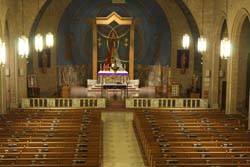
Ms. Landry was born and raised in Kaplan, Louisiana. Kaplan is a small town southwest of Lafayette that has a strong Cajun-Catholic heritage. Many Acadians have a strong sense of ethnic identity which distinguishes them from the Anglo-Protestants of north Louisiana and the French Creole Catholics of the New Orleans area. The Acadian identity, for many, engenders an ancestral connection with France. Ms. Landry explained that some of the music in the Latin Mass—Gregorian chant—is derived from many traditions of ancient Christian chant, much of it from what is now France. This music was codified, not written, by Pope Gregory the Great in the 7th century. When asked if this music felt like her heritage calling to her, Ms. Landry responded enthusiastically:
Yes! That is one of the connections that I had to this liturgy and this music. This is music that my ancestors experienced; this is worship that my ancestors experienced and was handed down for centuries. It is the oldest Christian traditional music there is. I'm very proud to be a part of that, I'm going to cry right now because I get emotional thinking about it. I'm very proud to be a part of that tradition that has been handed down for ages. (Landry 2016)
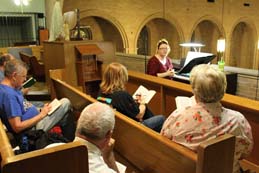
Ms. Landry discovered this connection by leaving her home in Kaplan and moving to Baton Rouge to study at Louisiana State University (LSU). When she began taking classes at LSU, she attended mass at the Catholic Student Center and found it to be even more modern than her church in Kaplan. She opted out of Mass for a while as she pursued a degree in musical performance as a percussionist. After that, she spent three years studying musicology at the Master's level. She focused on Catholic sacred music and said she learned more "about the Catholic liturgy in music history classes than I ever did in Catechism growing up." Another music student told her that St. Agnes had a traditional Latin Mass. The first time she went to church there she attended the regular Mass and said it reminded her of the traditional, pre-guitar Masses she attended as a very young child in Kaplan. One Sunday, her car broke down and she got a ride to church with a friend who said he only attended the Latin Mass. She said the service surprised her:
[I] expected it to be foreign and weird. I didn't expect what it was. What it was, was incredibly enlightening. It was everything my mother and grandmother were trying to teach me [as a child]. I just didn't see it in the new Mass; it was just all there. It just all made sense all of a sudden; my faith made more sense to me. (Landry 2016)
That was 25 years ago. Although she has been a member of St. Agnes parish for a long time, she has only been singing in the choir since 2012 and choir director since December 2015. She said some people say the old Mass and the new Mass are not all that different and that, "the old Mass just has more smells and bells." However, Ms. Landry has a precise understanding, appreciation and love for the highly structured old or Latin Mass and the parts of the Mass that are to be sung. She has worked to professionalize the choir in the sense that they rehearse weekly and to ensure that "the music is there in service to the liturgy, it is there to accompany the actions of the liturgy. It is not there for entertainment. Gregorian chant is not for the liturgy but of the liturgy." She added that much of what was taken out of the old Mass was repetition. However, the repetition was there for a reason. Some of the Gregorian chants include twelve repetitions of the same melody which Ms. Landry said, "almost puts you in a trance" or in other words, a meditative prayerful state in which one feels connected to God at a level of consciousness with no distraction. She said that she was taught that every Mass is "heaven coming down to earth" and she encourages the choir members to think of themselves as prayer leaders, to make their voices "resonant," and to "imagine your voice being incense going up to God; it is your prayers going up to God." When asked how a percussionist became a choir director, Ms. Landry distilled it into one word, unity:
It is two separate things. I haven't done it in so long. When I became a musicologist, I didn't really play that much. There has been more opportunity to sing which I prefer doing anyway. It is a much different experience because when you are a percussionist and you are playing in an orchestra, you are always a soloist, you are always the only one playing that part. When you are in a choir or a chorus, it is like being swept up in this wave of unity . . . which is a mark of the Church, being unified. (Landry 2016)
This feeling of unity was palpable during a sacred music concert of Lenten music held at St. Agnes Catholic Church prior to Easter in March 2016. The singing was done by two talented priests, Father Paul Yi and Father Charbel Jamhoury and a small choir composed of members of the St. Agnes Latin Mass choir who are also, like Ms. Landry, members of the Baton Rouge Symphony Chorus. The church was filled with people of all ages, with neighbors, and with people from all parts of Baton Rouge unified by their love of God, Catholic tradition, and the beauty of sacred music.
Most of the people who attend the Latin Mass, she said, do not live near St. Agnes. The congregation includes people who drive in from out of town and young families from across town seeking authenticity and tradition in worship. They have told her that they feel this authenticity in the holy, sacred, ritual of the Latin Mass. In her role as choir director, Ms. Landry celebrates and perpetuates the tradition of the Latin Mass. She sings in unison with her family traditions, with her mother and grandmother who sang in Latin and in English in the Catholic Church in Kaplan and with her ancestors from across the Atlantic who began chanting hundreds of years ago; the songs she sings today.
Janelle Couvillon
Choir Director, St. Thomas More Catholic Church
As of 2016, Janelle Couvillon has been the Choir Director at St. Thomas More Catholic Church for 30 years. Before she became the Director, she was a member of the choir for 16 years, since 1970. When she was first asked to direct the choir, she said she would only do it for a year because she loved singing and didn't want to give it up to focus on directing. She laughed as she discussed her 30 year tenure as director and said, "needless to say, I fell in love with it."
Ms. Couvillon is originally from Marksville and music in the church has always been a big part of her life. She grew up in the pre-Vatican II Church when all singing was done in Latin and the priest faced the sanctuary instead of the congregation. She said that being in the choir is a wonderful experience. Membership in the church choir is a family tradition; her mother was a member of her Catholic Church choir for 50 years and now Ms. Couvillon's daughter is a cantor at St. Thomas More.
In Marksville, Ms. Couvillon loved singing and dreamed of becoming an opera singer. She took piano lessons as a child and began to study voice in high school. In the 11th grade, she knew that music and voice would be her future career. She attended Louisiana State University (LSU) in Baton Rouge and during that time realized that she was going to marry and let go of her opera plan and instead pursued a double major in vocal performance and music education. During her LSU days, the choir director at St. Aloysius Catholic Church would pick her up and take her to their Mass so she could sing with their choir. Paid opportunities to sing in Protestant churches were available, but in those days she said, a "Catholic girl or boy did not go sing with a Protestant church." Ms. Couvillon has seen the blurring of those firmly drawn denominational lines during her career. Today, she said, Catholics are singing Protestant hymns in their Masses and Protestants are singing Catholic hymns in their services. This ecumenical song sharing began in the late 1960s and early 1970s after Vatican II.
All of the choir directors and musicians interviewed for this project spoke about the need for balance as they blend tradition with modernity in church music and Mrs. Couvillon works to incorporate both by including a blend of contemporary and traditional hymns, anthems, and songs including pieces sung in Latin. This was clear from the musical selections the choir prepared for a Lenten concert in 2016. Easter is the most sacred feast of the Catholic liturgical year; hence, tradition is more prominent during this time. In addition to contemporary pieces, the traditional pieces the choir sang included "Ubi caritas," a very old Catholic hymn with a Gregorian melody sung in Latin, and two other traditional Catholic hymns, "Oh Sacred Head Now Wounded" and "All Glory, Laud and Honor" which is a traditional piece that most Catholic churches sing on Palm Sunday. On Holy Thursday, there is a procession of the Holy Eucharist around the church to bring it to a place of repose where it remains unseen until Easter Sunday. Congregants sing "Pange lingua," a Latin hymn, as they process through the church.
The Catholic Church has always had more prescribed boundaries than Protestant churches but after Vatican II, the music selection for Catholic Mass blossomed. This is reflected in the diversity of choirs at St. Thomas More. There are four different Masses with four different musical offerings. The traditional choir is the one directed by Ms. Couvillon and most of their singing is accompanied by the organ or piano. The contemporary choir includes singing accompanied by guitar, upright base, violin, and piano rather than organ. There is a youth choir that sings once per month and some services feature a cantor and an organist.
The Catholic Mass is conducted according to ritual. This ritual makes the Catholic Mass familiar and comfortable for many. In the realm of church music, the type of music a church performs is up to the priest who may or may not choose to have a direct hand in it. Mrs. Couvillon explained that decisions about music at St. Thomas More are made during liturgy committee meetings in which the lay staff and volunteers meet with priests and discuss the focus of that particular season but not a specific plan for every Sunday. For example, during Easter season, "we know we are still going to do the same Mass setting or the same responsorial psalm."
The other major source of input is the congregation. Mrs. Couvillon said that she receives a lot of feedback, the people who attend the Mass with the traditional choir tell her that they love the choir and that particular pieces that the choir sings enhance the liturgy which enhances their worship. She said congregants will also tell her if they do not like something. She can also gauge how the congregation feels about a song by their level of participation. She said that the congregation loves to sing and she balances choir and congregational singing.
When Mrs. Couvillon joined the St. Thomas More choir in 1970, it had 50 members. Today, the choir is still large and includes 35-40 people. The choir includes people from a range of ages, a few professional singers, and Mr. Couvillon. When I asked if her husband was also a singer, Mrs. Couvillon said, "Yes, he is in the choir, he is in both choirs. I probably would not have lasted as long if he had not been a singer because it does require a lot of time away. Some spouses might resent that." Like many of the other choir directors and singers in this essay, Mrs. Couvillon and her husband do a lot of singing together. At the same time they joined St. Thomas Moore Parish in the 1970s, they joined what was then known as the Baton Rouge Choral Society and is now the Baton Rouge Symphony Chorus. She said that she and her husband are among just a few who have been in the organization "for a very long time, since its beginning." One of her favorite pieces that she has done with the Symphony chorus, a secular organization, is Mozart's "Requiem Mass."
She recalled that in the past, a Diocesan group would get multiple Catholic choirs together to give concerts and to sing for special occasions such as the 30th and 50th anniversaries of the diocese. In addition to joint Catholic choirs, she described joint neighborhood choirs comprised of the members of St. Thomas More, Broadmoor Methodist, and Broadmoor Baptist churches. For many years, St. Thomas More choir has participated in Sounds of CommUnity, the ecumenical concerts coordinated by the Interfaith Federation of Baton Rouge. St. Thomas More most recently participated in 2015. The theme was "Waging Peace" and the program was written specifically for Baton Rouge. It included music and narration and was derived from interviews of Baton Rougeans on how to make the city a more peaceful place.
Mrs. Couvillon spoke fondly of her mother's joy at having been a member of her church choir for 50 years. This year, after 46 years in the St. Thomas More choir as both singer and director, Mrs. Couvillon plans to retire from directing, but never from singing. It seems she is out to break a family record. In conclusion, Mrs. Couvillon beamed:
I could not imagine my life without music, without singing. . . . Up there it is God, family, and music. It has always been a big part of my life and I'm sure it always will be. I can't imagine not singing. Besides the symphony chorus, I'm in the Baton Rouge Music Club, . . . but singing in the church itself, the hymns just really speak to me. (Couvillon 2016)
Marcy Fisher
Music Minister, Greater New Bethel Full Gospel Baptist Church
Choir Director, Highly Favored
Musically and geographically, Marcy Fisher is all over the place because her focus is clearly centered on glorifying God from all directions. She has been directing choirs for over twenty years and has been immersed in sacred music her entire life (Robinson 2015). Currently, among many other roles, she is the Music Minister at the Greater New Bethel Full Gospel Baptist Church. She grew up singing in a family quartet, the Fisher Cavaliers, led by her father, Charlie Fisher. In addition to Ms. Fisher and her father, the early group included her father's three sisters, her two brothers, and three of her cousins. In addition to her church choir, she leads Highly Favored, a choir composed of women and men from various churches, with most of them meeting through the Full Gospel Baptist Churches. Her daughter sings with Highly Favored as well (Robinson 2015). She leads spirituality conferences for women and workshops for churches that want to learn about Praise and Worship. In addition, she is blessed to still sing along with her father with the Fisher Cavaliers. Last year, in 2015, the group celebrated its 35th anniversary by making a pilgrimage of performances from Jackson, Louisiana to Baton Rouge. In March 2016, she led a large mass choir for a celebration and honoring of Pioneers of the Gospel in Baton Rouge held at Antioch Full Gospel Baptist Church on Mickens Road. Much to her surprise, she was one of the honorees at this event organized to honor and formally thank the many Baton Rouge area music ministers who have been in the music ministry for years and have "paved the way for a lot of us."
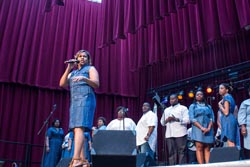
Like many of the other people interviewed for this project, the balance between traditional and modern and keeping the young and the older members of the congregation connected to the service through music is a continuous, adaptive process. She said her diverse musical back ground provides the tools necessary to achieve this balance:
That is what makes me so unique when it comes to music because I have experienced or been a part of it all. The Fisher Cavaliers, which is my family's group, is a quartet. So I've sung quartet, choir, and Praise and Worship. In school I was in a cappella choir so I have so many different facets to my musical background. So, when I go anywhere in any environment, I can adapt. There is the traditional setting, more of the old school Gospel like hymns, so I can fit in that environment. I can go into a quartet environment where it is strictly quartet singing and fit in that environment. If I go into a more contemporary setting, where there is more of the Praise and Worship, more of the new kind of singing, I can fit in that environment also. And then of course, my church, we have a little bit of it all and I guess it's because I'm the minister of music. I tap into it all, we have Praise and Worship, we have contemporary, then we have the traditional Gospel that we do. I'm very diverse when it comes to music. (Fisher 2016b)
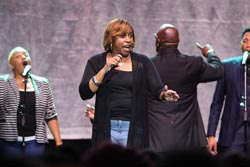
Musical genres are classic but they are also dynamic and split into many sub-genres. Ms. Fisher discussed the different genres and how they fit together. She discussed spirituals, Gospel, Jubilee singing and Praise and Worship. She said that, as a child she still occasionally heard spirituals in church. In 2016 she said, other than the ensemble called Heritage, most churches no longer sing spirituals and that spirituals mostly come up during February, Black History Month. Gospel, however, is a different story. She described Baton Rouge as a "traditional" town where most churches prefer Gospel to new, contemporary styles such as Praise and Worship:
When you come to Gospel singing, you can tap into choirs, into quartet singing. It is more of the clapping my hands, stomp my feet type songs. And, of course, you have moderate, you have up tempo, and you have the slower type songs. As I got into middle school in the early 1980s, that is when the Gospel started coming. You had artists like John P. Kee, Shirley Caesar, those type singers, the more traditional Gospel. Gospel, you have a whole lot of Jubilee, you have a whole lot of standing up, whole lot of clapping. Gospel is more about the halleluiah and the "Praise God!"—the excitement and jubilation. Baton Rouge is more of a Gospel city than anything else, and therefore Praise and Worship has not quite taken off here yet. It has been that way probably all of my life, more of a Gospel city. When you go to musicals the music schools, you would see that it is mostly Gospel because that is what people are used to in this area. (Fisher 2016b)
Ms. Fisher travels throughout south Louisiana giving workshops and working with her pastor. At the time of this interview, she was serving as the District Overseer for the Full Gospel Baptist Church Fellowship in Baton Rouge. She has observed that, like Baton Rouge, the rural areas are strictly Gospel churches. She said New Orleans has embraced Praise and Worship and that Lafayette is more of a blend, "I think Lafayette is more of a mixture. They have a lot of Cajuns there, a lot of Catholics. It is more of a mixture. We had a musical there last month and there were several choirs from that area; they did Praise and Worship. They did Gospel as well."
She describes Praise and Worship as a "whole different ball game." She says, "Praise comes from a place in which you praising Him for all that He has done; Worship comes from a more intimate place in which you're not asking Him for anything, but just giving Him worship for who He is!" Gospel is communal, can be loud, active, and is often about struggle:
A lot of people say Praise and Worship could be Gospel, but it really isn't. Praise and Worship is more contemporary. There are some songs for the praise time where they may tap into Gospel but worship is more of an intimate time with you and God. The worship songs are totally in adoration of God. Not that the other songs are not, but Praise and Worship gets you more into an intimate space. . . . You are a little bit more settled. You are trying to get people into an area where they are getting ready to go into the presence of God. It is just them and God and you are blocking everything else out. (Fisher 2016b)
Her church, Greater New Bethel Full Gospel Baptist Church, balances these different musical preferences by alternating weekly Praise and Worship services led by a praise team on the first and third Sundays of the month with Gospel services led by a choir on the second and fourth Sundays of the month. The praise team includes about six people in most cases, each with their own microphone and they each have an individual part although they sing together. Choirs tend to be larger she said and each type of singing requires different skills:
Because of the different types of songs between praise and worship and choir, some people that sing strictly on a praise team, may have some difficulty singing with a choir. Likewise, some people that sing in the choir, can't sing on the praise team. Choir, you can just about get anybody that wants to sing-even though they may can't sing as well as others, but you are not on an individual mike, you are in a group of people. Praise team, it is just you and that mike, so whatever you put through that mike, that is exactly what is going to come out. The two types of singing are very distinct, and because of the type of songs that are also sung during Praise and Worship, you have to have the correct demeanor, the correct posture, and the be a willing vessel to allow the spirit of God to take up residence. Most of the time praise and worship is done at the beginning of the service, because you want to get the parishioners in a place where they allow God to saturate the atmosphere; it is a totally different zone. We say this all the time, everybody can praise but everybody can't worship. (Fisher 2016b)
Although her church specifies different types of music every week, Ms. Fisher said they still try to blend the styles to provide something for all ages. She said they also include a hymn once a month to stay true to their foundation, "In the second Sunday which is our communion Sunday, we do a hymn. We don't do hymns every Sunday. In some churches, hymns have been totally taken out of the worship, but hymns are very important; they are the foundation. "Amazing Grace" and some of these other hymns that I grew up on, that is really the foundation of the church."
The "Marcy Fisher remix" is what her choir calls the unique blend of songs that she creates, sometimes spontaneously in the middle of a service, in order to meet what she reads or feels from the congregation, the pastor, the Holy Spirit, and God. She said that the entire congregation has to be able to "connect" with the music on some level, and her diverse musical background enables her to cook the songs to meet the needs of those who are there. She provided an example:
There is an old school song called, "Victory is Mine, Victory is Mine, Victory Today is Mine," so what I may do is tack it on to the front of the New Day song and say, "Okay, we are going to do this for y'all" At the end I'm going to say and "Now, we are going to go and do this this way." So, hook them together, I do that a lot. Hook them together so I encompass everybody. A couple of months ago they the choir were teasing me, "you put quartet, choir, and Praise and Worship all in one song." I was like, yeah, I can do that!" When I went back and thought about it, I was like, yeah, I did! When you have all different kinds, it helps to make a good gumbo, when you have all kinds of ingredients in it that is what makes it good. So I have all kind of ingredients in my musical background. (Fisher 2016b)
Ms. Fisher said she is fortunate because her pastor does not require a weekly song list because he knows that the music has to be spontaneously adapted in order to respond to what the congregation experiences, how the Holy Spirit moves and what God want to accomplish:
My pastor knows I'm in tune to the Holy Spirit. There have been times when I have given the choir the songs and we put them up on the screens and as I have been walking up I'll tell the musicians, I need to switch the songs because there is something that has taken place in the House and God is saying, "No, I want you to go a different route." The ear is so important, when I'm doing workshops, I tell people all the time, you've got to have an ear to listen for the voice of God, to listen to what God is saying, where he wants you to go in that particular service because there is a need that he has to attend to and this particular song is what is going to meet that need. Navigating is all about making sure you stay connected with God, and of course, coordinating with the pastor. Navigating sometimes can be difficult but when you have been doing it for a while and when you are sensitive to what the Holy Spirit wants to do then it makes it much easier when it comes to choosing what to do in this period. I can be sitting in service, we have service tonight, and during the intercessory prayer, I can tell by the flow what songs we need to do. (Fisher 2016b)
A connection with one's pastor, listening and being watchful is critical to ensuring the music is right for the congregation. She said music is her life; it has helped her survive struggles; it brings her great joy. The role of music in facilitating the congregation's connection with God is critical:
I tell the choir and praise team, "Don't ever take it lightly because singing is a ministry." We are actually ministering to people through song so even before we go over to the other building on Sundays, we come in here and we pray every Sunday because I don't want anything to get in the way of what we need to do to get people to where they need to be. Besides the pastor, the music ministry is up before the people more than anybody. It is music ministry and the pastor. The music ministry, the music is what tills the ground for the word to come forth so if the music don't till the ground, then the word can't be planted correctly and then the pastor has to work really hard because he has to till the ground and plant the seed. (Fisher 2016b)



